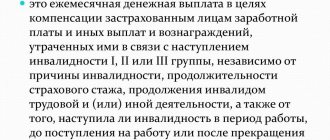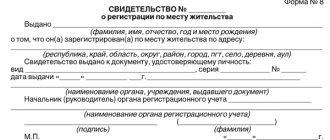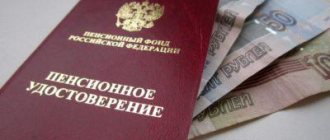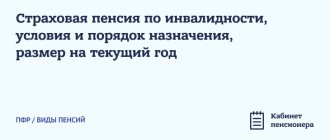"Pension" story
The word “pension” itself appeared in the Latin language, it was invented and introduced into use by the well-known Julius Caesar. Translated from Latin, it means “payment.” This payment was made in cash and was intended as a social benefit for military personnel of that time. Such monetary payments were often assigned as awards, which came not only directly from the state, but also from private organizations of various types.
In the Russian state, pensions were adopted at the legislative level under Nicholas the First. They were also carried out for military personnel in the officer rank and with a long service life - from 25 years. But this required fulfillment of a number of conditions:
- service in government bodies;
- flawless performance of their immediate duties. Although with the advent of Soviet power, all pension payments of the tsarist regime were abolished.
Pensions in the USSR
The law on pensions was adopted in the USSR only in 1954. It dealt not only with military personnel, but also with other workers in a wide variety of labor fields. At the same time, the size of pension cash payments was at a sufficient level - about 100-120 Russian rubles of that time. But the size of such a pension payment for a Soviet citizen depended on the worker’s length of service, his specialty and salary. Thus, a typist who received a salary of 120 rubles could expect a monthly pension payment of 65 rubles. And the chief accountant with a pre-retirement salary of 120 rubles – in the amount of 105 rubles.
“Soviet” pension payments were calculated based on the full earnings of the future pensioner.
This was not the amount of money that the employee or employee received after all taxes were withheld. And the spread was significant at that time. So, for agricultural workers:
- minimum pension – 34 rubles;
- the maximum pension is 102 rubles.
For this category of Soviet citizens, there was a reservation: working agricultural pensioners received a cash pension payment every month in full, and their wages did not have any impact on this.
For employees and workers of retirement age in the USSR, a certain amount was established, which included pension payments and wages. That is, a working pensioner could not have an income higher than this amount. If the limit was exceeded, then, accordingly, there was a decrease to the required value.
Interesting Facts
Pensions in the Soviet Union are often described in two terms.
Positive : any citizen of retirement age in the USSR received support in the amount of 100-120 rubles every month.
Negative : citizens of retirement age under the Soviet Union lived very sadly: literally on 15 rubles a month. To be fair, let's say that both of these opinions are fair.
The size of the pension in the USSR is now assessed differently by people
The amount of the pension in those days was related to salary. For example, if a woman worked as a cleaner, then in retirement she will be paid about 80 rubles. An experienced specialist was paid about 130 rubles. The respected Bolshevik had the right to be provided with a personal pension of Union significance, amounting to 300 rubles. If a citizen did not work enough time, he had the right to receive a social pension - 35 rubles. This figure is considered the minimum for the USSR. We can conclude that the average pension amount in the USSR reached approximately one hundred rubles.
Citizens living in villages were provided with pension payments that were 15% less than workers and employees. Thus, the largest amount is 102 rubles, and the smallest is 34. However, village residents had their own privileges over city residents. The first received pension money in full, regardless of the amount of earnings. And for the second, income could not exceed a certain number. If the threshold was exceeded, the pension was reduced by the amount of the difference.
Old-age pensions were issued on a general basis to the male population aged 60 years and over, and to the female population from 55 years old. It was necessary to work for 25 and 20 years, respectively.
Of course, the size of the pension largely depended on the position of the citizen and his work experience
An old-age pension was issued if a person did not work the required time, and also:
- he reached retirement age while performing his job duties;
- he has worked for a total of at least five years;
- before retiring, he worked for at least three years;
- he applied for a pension no later than one month from the date of completion of work. Please note that there are no allowances for such pension payments.
So, the pension payment system in the USSR is in many ways similar to the one that exists now in modern Russia. The amount of payments largely depends on the employee’s length of service, his salary, and for special merits or residence in the Far North, you can receive various allowances and privileges.
What conditions for retirement existed in the USSR?
Pension payments for Soviet pensioners were usually taken from social insurance contributions, which were provided by the state itself. In those days, such insurance premiums were not tied to the salary of the future retiree. And if such contributions were not made by the employee, then the Soviet citizen still had the full right to pension provision upon reaching a certain age threshold of “old age”. The general basis for retirement during the USSR was the following age:
- for men – 65 years (work experience – 25 years);
- for women – 60 years (work experience – 20 years).
If a Soviet worker reached the retirement age threshold, and his work experience was incomplete, then a pension was assigned to him under certain conditions:
- Achieving the required age threshold during working life.
- The total work experience must be no less, but more than five years.
- The pre-retirement period (that is, just before retirement) is more than three years.
And it was necessary to start registering for retirement a month before the end of pre-retirement work.
How wages in the Soviet years affect retirement
For each officially employed employee, the employer pays insurance contributions to the Pension Fund (PFR) from their salary. The transferred amounts are automatically converted into points and stored in the citizen’s personal account. It is beneficial for a person to have higher earnings, since the deductions will be higher.
As a result, more PB accumulates, so the amount of pension benefits will also be higher.
The point system began to operate in Russia only after the pension reform of 2015. Pensions for Soviet times and up to 2002 are now also converted into points, but a separate formula is used for this. For the period from 2002 to 2015, earned pension capital is used to calculate the PB.
When recalculating pensions for Soviet times, you need to know the amount of earnings. This will help determine what income is profitable to calculate:
- Refer to salary data for the period 2001–2002. The information is available in the Pension Fund and is used by default.
- Take a pensioner’s earnings for any 60 consecutive months. You will have to provide the information yourself if it is not included in the payment file.
Formula for calculating pensions until 2002
The number of PB earned by a citizen during the USSR and before 2002 can be determined by the formula:
Number of PB = amount of settlement capital / cost of 1 PB as of January 1, 2015 (64.10 rubles).
- 5 ways to slow down the aging of the body
- Apartment mortgage insurance - the best offers, required documents and cost of the policy
- Contributions to the Pension Fund - calculation rules, payment terms and how to check the transfer
To determine the amount of estimated capital, you need to make certain calculations:
- Find out the experience coefficient (SC). It is 0.55 for men who have worked for 25 years and women with 20 years of experience. For each additional year of work, 0.01 is added. The ceiling is set at 0.75.
- Determine the coefficient of average monthly earnings (ASM). For this, we need data on wages, which will show how profitable the calculation is. When calculating, the average monthly income is divided by the average salary in the country for the same period of time.
- Calculate the amount of the estimated pension (RP). The size of the experience coefficient is taken into account:
If does not exceed 0.55:
RP = SK x KSZ x 1,671 – 450, where:
- 1 671 – average salary in the country in December 2001;
- 450 – the basic amount of pension payment established by law No. 173-FZ (12/17/2001).
The value (SC x KSZ x 1,671) cannot be lower than 660. If during calculations the resulting amount is lower, the RP value is set at 210 rubles.
If above 0.55:
RP = (SK x KSZ x 1,671 – 450) x Experience, where:
- Experience for women = number of years worked before 2002 divided by 20;
- Service experience for men = number of years worked before 2002 divided by 25.
If the calculations (SC x KSZ x 1,671) result in less than 660, the RP value is set at 210 rubles.
- Carry out valorization. This is a one-time increase in the received RP amount by 10%. The valorization of Soviet-era pensions provides an additional bonus for those employees who have work experience before 1991. For each full year, 1% is added to the existing 10%.
- Use a correction factor. The valorized RP amount is multiplied by 5.6148. This is the product of annual inflation indices between 2002 and 2014.
Limiting factor
Speaking about the average earnings coefficient, which determines whether it is profitable to take into account income in Soviet times, it is important not to forget about one subtlety. The legislation establishes that it cannot exceed the value of 1.2. The exception is residents of the Far North and similar areas. For them, the permissible value varies from 1.4 to 1.9 depending on the area of residence.
Pension supplements in the USSR
Yes, during the Soviet era, pensions were also supplemented with bonuses. In what cases were they provided to pensioners of that time?
- If, in fact, a Soviet pensioner worked in one workplace all his life, then such an allowance was mandatory.
- If the pensioner was dependent on family members who were officially recognized as disabled (for example, disabled people).
Thanks to such bonuses, the size of the usual pension monthly payment reached 120 Soviet rubles. For full members of the Academy of Sciences there was an allowance for the academic title - 500 rubles, and for corresponding members - 400 rubles. Moreover, such additional amounts of money were fixed for life.
What was the pension in the USSR? (4 photos)
Author: ServerNotFound
11 September 2021 12:56
Tags: USSR were stories pension become
5619
4
July 14, 1956 is the day when pensions appeared in the USSR. Then the corresponding law was adopted. According to it, men could count on pensions from the age of 60, with at least 25 years of experience, women - at 55 years old, and they had to work for the benefit of the state for at least 20 years.
0
Moreover, if a person worked in difficult conditions, for example in the Far North, or performed work that was significant to society - a teacher, a doctor - it was possible to retire earlier. The size of pensions depended on wages. In cities, pensioners received an average of 70 to 120 rubles. The minimum pension in the USSR was 35 rubles. This is the so-called social pension, which was intended for people who did not work, or those who did not receive the required length of service. The pension was calculated based on either the average salary that a person received a year before entering a well-deserved retirement, or, at his choice, for any five-year period out of ten years of continuous work. For additional length of service, bonuses were awarded: for 35 years of experience for men, and 30 years for women, as well as for work without breaks for more than 15 years, 10 percent were due; for 25 years of work in the same place with a total work experience of 35 years an additional 20 percent was due. The maximum old-age pension was no more than 120 rubles. A feature of the Soviet pension payment system was that there was no centralized unified pension fund. Enterprises paid insurance contributions to the budget, and pensions were paid from these funds. A separate discussion is the collective farmer’s pension. Collective farm artels, which had a special fund for such payments, were responsible for their provision. In 1964, with the adoption of new pension legislation, the country committed itself to paying pensions to all citizens. The USSR made a significant contribution to the politics of modern Russia in many ways. It was during the existence of a superpower that comprehensive pension provision was created. This historically important law was issued on July 14, 1956. To calculate the pension salary, two options were used: At the request of the future pensioner, one of the five-year plans was selected, which was included in the ten years of continuous professional activity, and the average salary in it was calculated. The basis was the salary a person received one year before reaching retirement age. PENSION IN THE 1980s In 1980, the number of pensioners in the Soviet Union increased significantly. However, this did not prevent the state from paying their pensions on time at the same level, taking into account inflation, as before. The average pension salary in these years was 67 rubles. PENSION SIZE IN 1985 In 1985, thanks to inflation and rising living standards, pensions in the USSR reached their peak, its average value was 72 rubles. At the same time, collective farmers received a significantly smaller amount than city residents. Their pension averaged 47 rubles. AVERAGE PENSION Over the entire period of the existence of the USSR, the size of the average pension provision has undergone significant changes. The reason for this was not only inflation, but also a significant increase in the standard of living among Soviet residents. And, if in the early 1970s the average pension was only 34 rubles, then by 1986, this amount increased to 76 rubles. In general, the pension salary of those years is quite consistent with the amount of money received by modern pensioners. MAXIMUM PENSION In the USSR, the maximum pension was 120 rubles. City residents working in areas of mental work could count on it: engineers, doctors and teachers. Naturally, it was received by people who had worked full time. Pension of people's deputies
0
Pension of people's deputies In 1989, people's deputies were appointed as the highest authority, who held congresses to discuss government issues. The last congress took place on September 5, 1991. It was on this day that the decision was made to dissolve the deputies. At the moment, the majority of people's deputies have retired due to old age and in the State Duma they raised the issue of increasing pension payments for this category of citizens. Today the number of “former” people’s deputies is only 285 people. The Ministry of Labor and Social Protection proposes to set the pension amount at 200,000 rubles. The main reason for the draft law was the elimination of the provision on personal pensions for this category of citizens, according to which people’s deputies and their families could receive a decent pension. Law on Pensions The main bill of the USSR, which regulated the issues of calculating pensions, is the law “On State Pensions” dated July 14, 1956. The law establishes such important points as: maximum retirement age; experience; average monthly pension, etc. Many points of the bill are outdated, but the reform developed in 1956 allowed older people to receive a decent pension. At the same time, annual inflation was not taken into account, because prices for goods only grew every year. Therefore, adjustments were constantly made to the reform, and even at the moment the authorities are planning to radically change the pension system so that citizens can independently form their future pension. Interesting Facts
0
Interesting facts Pensions in the USSR are most often written in two forms. In the rainbow: every Soviet pensioner received 100-120 rubles per month. In brown: Soviet pensioners lived on 10-15 rubles a month. It’s interesting that both the rainbows and the browns are right in their own way... On a single scale, the old-age pension on a common basis for workers and employees was calculated as follows (1980s): Monthly earnings in rubles | In % of earnings | The smallest pension amount in rubles Up to 50 rubles. - 85% of earnings - 40 rubles. From 50 to 60 rubles. — 75% of earnings — 42 rubles. 50 kopecks From 60 to 80 rub. — 65% of earnings — 45 rubles. From 80 to 100 rub. — 55% to earnings — 52 rub. From 100 and above - 50% of earnings - 55 rubles. The size of the pension in the USSR depended on salary. A cleaning lady on a well-deserved rest received 70-80 rubles, a specialist - 120-150. Some old Bolshevik could receive a personal pension of Union value - 300 rubles. For people who, for some reason, did not work or did not have enough work experience, a social pension of 35 rubles was provided - the minimum pension in the USSR. The average pension in the USSR was thus approximately 100 rubles - the cost of half a ton of wheat bread or a men's three-piece suit made of pure wool. Rural residents were assigned a pension 15% less than workers and employees. That is, the maximum pension for this category of citizens was 102 rubles, and the minimum was 34 rubles. At the same time, villagers had a certain advantage over workers and employees. The fact is that working rural pensioners received a full pension, regardless of the amount of their earnings. For workers and employees, this was more complicated - a working pensioner could not have a total income (pension + salary) above a certain amount. If the limit was exceeded, the pension was reduced by the amount of this very excess. The old-age pension was established on a general basis when men reached 60 years of age, and women reached 55 years of age, with a total work experience of at least 25 and 20 years, respectively. An old-age pension with incomplete work experience was assigned to workers and employees in the presence of the following conditions: reaching retirement age (see above) during the period of working activity, if they worked for a total of at least five years, immediately before retirement they worked for at least three years , applied for a pension no later than one month from the date of termination of work. Please note that no supplements were accrued to this pension. Supplements were also provided to the standard pension (this did not apply to pensioners with incomplete work experience). Bonus 1: For continuous work experience (more than 15 years) - 10%. Bonus 2: For long work experience (over 35 years for men and over 30 years for women) - 10% Both bonuses could not be accrued at the same time. Either the first or the second. Bonus 3: For long continuous service at one enterprise (25 years) with long total experience (35 years) - 20% This bonus could not be accrued with other bonuses
0
Source:
More cool stories!
- Short stories and incidents from life
- A British man tried to steal a car with three children in the back seat
- In St. Petersburg, a man mistook a physicist with a telescope for a thief, and accidentally “killed” him with a slap on the butt
- 16 celebrities with unusual talents and hobbies
- Why sharp-crested tits “steal” animal fur
Tags: USSR were stories pension become
Do you like to remember how things were before? Join us, let's feel nostalgic together:
48 15 33
Liked
33 2
44
Partner news
"Elite" Soviet pensioners
It turns out that during the Soviet era, pensioners had two “elite” categories. The first group included retired military personnel, and the second group included those individuals who were lucky enough to become the owners of personal pension payments. Such personal pensions were introduced back in 1923. And over time, the legislative pension system and, accordingly, the size of personal pensions have changed. Thus, a member of the Politburo of the CPSU Central Committee received 500 rubles a monthly pension, a candidate member of the Politburo - 400 rubles, and a secretary of the Central Committee - 300 rubles. At the same time, “elite” pensioners were assigned cars with personal drivers and country houses.
Attention! As part of our website, you have a unique opportunity to receive free advice from a professional lawyer. All you need to do is write your question in the form below.
Pension calculations
If the salary was:
- up to 50 rubles per month, 85% pension – 40 rubles.
- from 50 to 60 rub. – pension 75% – 42.50
- from 60 to 80 rub. – pension 65% – 45 rubles.
- from 80 to 100 rub. pension 55% – 52 rubles.
- from 100 and above – 50% of earnings..
A member of the Politburo received a pension of 500 rubles. Candidate – 400. Secretaries of the Central Committee – 300. Military pensioners up to colonel – 250 rubles. Above – 300 rubles. Academicians – 500 rub.
Citizens who became disabled at an enterprise or due to occupational diseases received
- Group I – 110% of salary.
- Group II – 100% of salary.
- Group III – 65% of salary.
For general diseases;
- Group I – 100% of salary.
- Group II – 90% of salary.
- Group III – 45% of salary.









